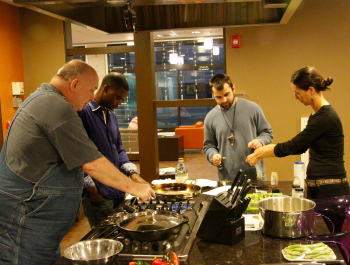Image

Dana Totman, president and CEO, Avesta Housing
Challenge: More than 40 years developing and managing affordable housing has taught Avesta Housing that building a large room, putting in some tables and chairs and labeling it “community room” is not enough. But what does it take to build and sustain community in affordable housing?
In 2013, Avesta Housing built 409 Cumberland, an affordable multifamily complex in the Bayside Redevelopment Area of downtown Portland, ME, as part of the “Vision for Bayside” revitalization plan unanimously adopted by the Portland City Council. The Bayside Plan states that it “will fill in, extend and enhance the existing residential fabric with a substantial amount of new housing units” and that “a diversity of dwelling types will enable citizens from a wide range of economic levels, age groups and life circumstances to live in Bayside.” Affordable housing was critically needed in the neighborhood, where 38 percent of the population is below the poverty rate and 83 percent live in low-and-moderate income households.
Among the 57 apartments at 409 Cumberland, 46 are affordable to households earning less than 60 percent of the area median income. The mixed-income development has attracted a diverse resident population, including formerly homeless people, immigrants, retirees, young professionals and graduates from a local program that provides post-secondary education and training to young adults with developmental disabilities. Residents can walk or bike to shops, restaurants and services in downtown Portland. The building has sustainable features such as a super-insulated building envelope, a high-efficiency heating system, a low-impact storm water management system, energy-efficient appliances and lighting and environmentally-friendly paints, materials and plumbing fixtures.
City planners requested that the first floor create a sense of life that incorporates outside activity, so this level is surrounded by floor-to-ceiling windows that blur the line between indoors and outdoors. Residents can relax, work or socialize in comfortable couches or at high-top tables. Community groups use the first floor for free for health-related events and classes, most of which are open to the residents. The building hosts yoga, cooking and meditation classes and is becoming the neighborhood’s hub for healthy food and healthy living.
Avesta’s vision for 409 Cumberland included the creation of a community that reflected the priorities of Portland as a whole, such as the city’s focus on health and food systems. The building combines healthy living and an urban location to create an exceptional community. The rooftop features garden beds and a greenhouse where residents can grow their own vegetables year-round and the Healthy Living Center on the ground floor includes a demonstration kitchen where residents can learn how to make the most of their harvest, thanks to special programming by local nonprofit Cultivating Community.
 A Cultivating Community Urban Agricultural Specialist works with residents to plant, maintain and harvest their garden plots. Following their experiences with food from seed to harvest, residents bring food they grow to the demonstration kitchen to learn, practice and share healthy cooking techniques and recipes. Residents bond as they help each other learn and succeed in the gardens and kitchen and share their history and culture through food.
A Cultivating Community Urban Agricultural Specialist works with residents to plant, maintain and harvest their garden plots. Following their experiences with food from seed to harvest, residents bring food they grow to the demonstration kitchen to learn, practice and share healthy cooking techniques and recipes. Residents bond as they help each other learn and succeed in the gardens and kitchen and share their history and culture through food.In a resident survey, respondents indicated vast improvement in their living conditions. Some residents were previously homeless, while others experienced a significant rent decrease upon moving to the building. In addition to affordability, residents cited location, quality of apartments, gardens and the healthy-living focus as key improvements to their lives.
Affordable-housing developers and property managers face the challenge of designing a building that will create community and bring residents together for meaningful and positive shared experiences that develop their interest in supporting one another. Avesta learned several lessons through the 409 Cumberland experience, including:
- The vision for community starts in the building design... Community spaces must be thoughtful and intentional. The rooftop urban agriculture, teaching kitchen and community rooms were all part of the original design. These spaces are critical to the programming and activity so essential to this community.
- …but it takes more than a good design to create and support community. “If you build it, they will come” does not work. It takes services and programs to create a community room that residents use. Avesta increasingly invests resources into engaging residents in meaningful ways that become more about building community and less about building rooms.
- Know what you don’t know. Although Avesta had a clear vision that healthy-living and urban agriculture would be the core values at 409 Cumberland, we also recognized that those topics are not our strengths. By partnering with Cultivating Community, we benefit from expert urban agriculture guidance.

